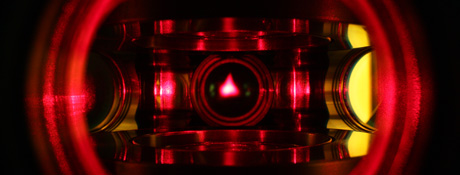Heidelberg Scientists Observe Paradoxical Quantum Phenomenon
8 December 2010
 Photo: Selim Jochim
Photo: Selim Jochim
For the first time ever, scientists have supplied experimental proof of the existence of the “Efimov effect”, a phenomenon that has aroused controversy for decades and has so far been only indirectly observable. This apparently paradoxical phenomenon hinges on the fact that three atoms can associate with one another even if the forces between two particles are too weak to bind them. This quantum trimer effect – a universal quantum property– was predicted theoretically in 1970 by the Russian physicist Vitaly Efimov. Now a team of physicists from Heidelberg University and the Max Planck Institute for Nuclear Physics headed by Prof. Dr. Selim Jochim have furnished direct proof of the behaviour of Efimov trimers. Their findings have been published in “Science”.
The Efimov trimer is a spherical quantum object appreciably larger than the usual three-atom trimers that chemists are familiar with. To observe the behaviour of the Efimov quantum trimer, the scientists used lithium-6 atoms to produce an ultracold gas with a temperature about one-millionth of a degree above absolute zero. At higher temperatures the atoms are more excitable and thus collide more strongly and more frequently. This would make observation of sensitive Efimov states impossible. “The Efimov effect is much weaker than the typical interactions between atoms that make for chemical bindings,” says Prof. Jochim.
For the production of the ultracold gas, the lithium-6 atoms were slowed down via laser light and captured in a so-called optical trap. But an initial “push” was necessary to place three lithium-6 atoms at the right distance from one another to form an Efimov trimer. To do this, the atoms have to adjust their atomic “innards” to the three-way constellation. The nucleus of a lithium-6 atom has a so-called nuclear spin and behaves like a tiny magnet. For the three atoms to associate, their nuclear spins have to be aligned in the right way. The scientists achieved this by exposing them to a radio field. The result was an actual Efimov trimer.
Though the trimer had only a very brief lifetime of less than a thousandth of a second, this was long enough for Prof. Jochim’s team to take a closer look at the Efimov state. They were able to demonstrate that quantum trimers really do behave in the way predicted by Valery Efimov. In the further course of his research work at Heidelberg University’s Centre for Quantum Dynamics, Prof. Jochim intends to produce trimers with a longer lifetime in order to decipher the universal quantum properties with greater accuracy. “Universality means that it is no longer important what concrete physical system and what force we observe,” Prof. Jochim explains.
For more information, go to www.lithium6.de
Note for news desks
Digital picture material is available from the Press Office.
Original publication
T. Lompe, T.B. Ottenstein, F. Serwane, A.N. Wenz, G Zürn, S. Jochim: Radio-Frequency Association of Efimov Trimers. Science, Vol. 330, 12 November 2010, 940-944, doi: 10.1126/science.1193148
Contact
Prof. Dr. Selim Jochim
Institute of Physics
phone: +49 6221 516229
jochim@uni-heidelberg.de
Communications and Marketing
Press Office, phone: +49 6221 542311
presse@rektorat.uni-heidelberg.de

